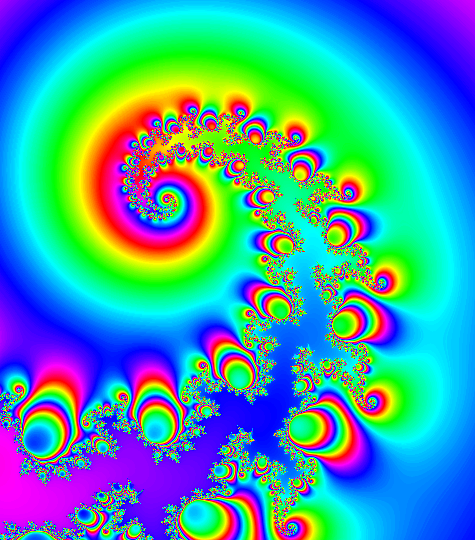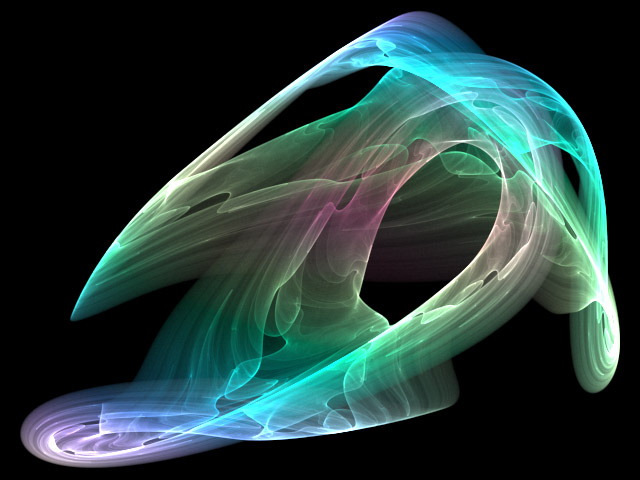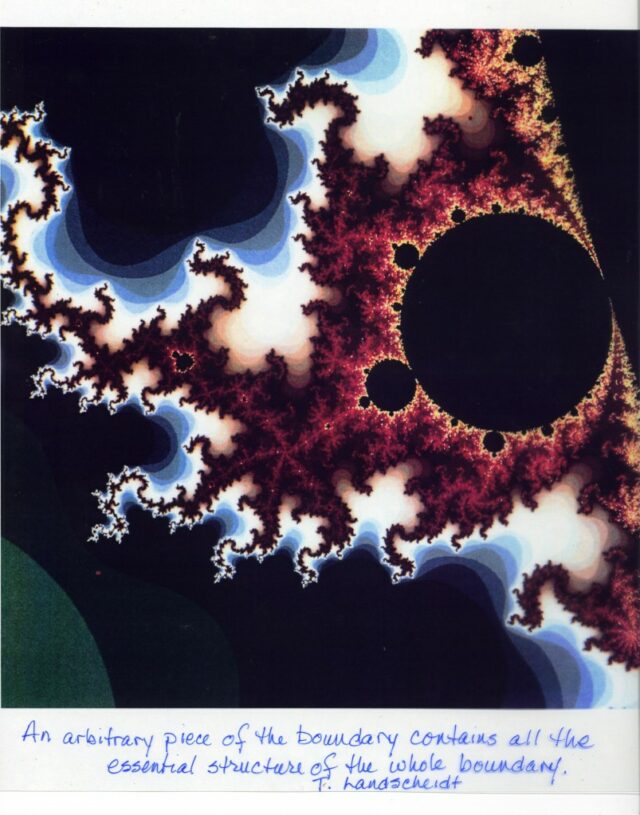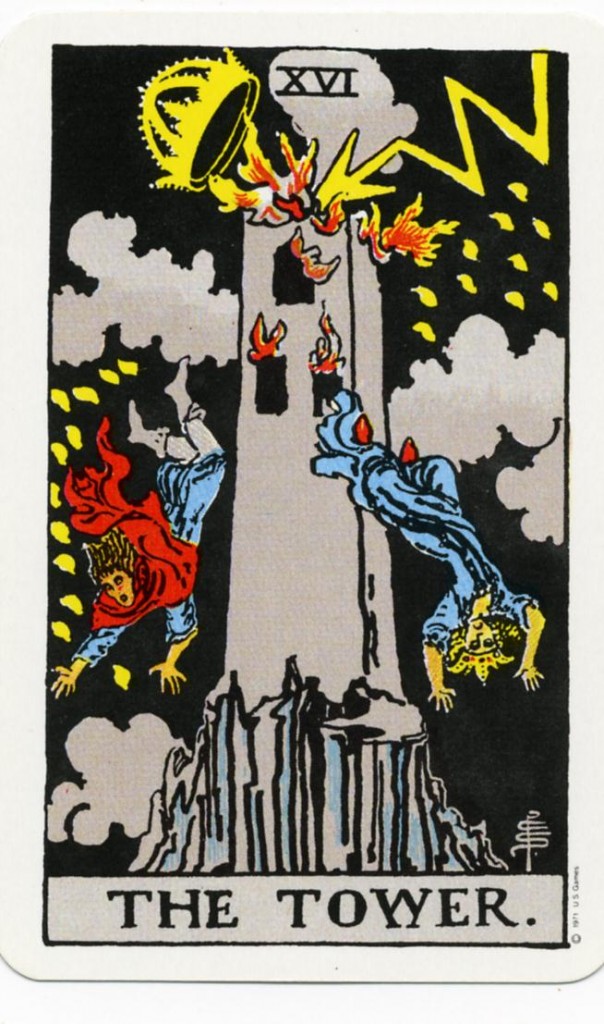Part Two: Fractals, and the science of chaos. How these principles can be applied to today’s multiple changing systems. And yes, more astrology references—after talking about how time is fractal in nature, we ask how can we identify repeating cycles and find several answers through astrology. Then we look at what happened the last time we were in a similar cycle.
Fractals and Chaos Theory
One of the huge breakthroughs in our understanding of the world came about through the study of chaotic systems and the resulting science of Chaos. As things go, this is old stuff by now—reaching huge popular awareness in the 1970’s. But we are still learning how to think in these terms, especially when we think about chaotic systems like, well, societies! Understanding chaotic systems seems like a useful skill when we’re facing the many changes in front of us these days.
What defines a chaotic system is “non-linearity”. In a linear system, any change you make to it has predictable results. Mixing paint colors, once you know the proportions and rules, will reliably give you the same results every time you do the same thing. The actions are controllable. No outside factors are involved. Mixing paint colors in open vats in a chemical storm, on the other hand, could give quite unpredictable results. That is because the multiple variable involved—the winds, the multiple chemicals and their effect on colors, the random mixtures of the multiple chemicals and winds—create a non-linear system, which is chaotic and unpredictable by nature. And nonlinear systems have their own feedback loops, which mean that their patterns of chaos build on themselves to create even more complex situations.
In fact, Chaos theory was developed by studies of weather systems. You’ve probably heard about the flapping of a butterfly’s wing in China could be the cause of the hurricane in Brazil… This is the part of chaos theory that says outcomes are based in sensitive dependence on initial conditions, or SDIC.
Conrad Lorenz initially believed that if you programmed in all the possible weather interactions into a gigantic computer, and ran a simulation, the simulation would create the same results each time it was run. To his amazement, not only didn’t it work that way—but the more he refined the system, taking into account more and more variable, the less predictable it became. Each additional detail added its own feedback loops, which added even more complexity to the resultant pattern. To Lorenz’s utter amazement, the graphs plotting his weather systems were indistinguishable from a graph of cotton prices in the 1800’s in the office of a history professor… so Lorenz then began studying how complex, non-linear systems were alike, and thus was born the science of Chaos.
James Peterson, the head of the futurist think-tank, The Arlington Institute, says that the present global economic system alone is so complex that it is, literally, a chaotic system. There is no way we can tweak this or tweak that part of the economic system and get a predictable or reliable result. It is a non-linear system, which means that nothing we do to it will result in predictable outcomes. The best we can do is guess, and hope for the best. And the economic system is only one of many non-linear systems going into crisis before our eyes.
But the mathematics of chaos does offer hope. We can see this best through fractal images. These are visual outcomes of mathematically complex formulas with built-in feedback loops. Fractal images allow us to see how simple patterns play out in increasingly complex patterns. Fractals are controlled, mathematical images of chaos.

Fig 2. A Fractal Image
Self-Similarity and Boundaries
In a fractal image, we can see the pattern repeat over and over, with tiny variations in each repetition. In the image above, you can see the original large loop replicated, with tiny differences, along the edges of the spiral. At first, it looks like the same image, but closer observation reveals the differences. These repeating patterns are self-similar.
The edges of a fractal image are its “boundaries”. The boundary is where the original pattern is most subject to change and variation. Chaos scientists have discovered that the ONLY truly creative point is at the point of the greatest chaos. The boundary between known order, and unpredictable chaos is, quite literally, the ONLY point of creative change. This is the point where scientists say the “probabilities” ultimately “condense” into totally new and previously unimaginable patterns.
The good news here is that we’re quickly approaching total chaos. Yes, that’s the good news. That’s where new systems can arrive!
Theodore Landscheidt, a researcher in chaos science, says:
It is inherent in the emergence of boundaries that their creative potential is irresolvably linked to instability. However, it is just this instability…which can lead to a spontaneous formation of new structures…out of chaos.
This also applies to…the boundary between consciousness and subconsciousness, the transition from waking to sleeping, creative acts of artist, eureka moments, mystic experience, birth, death….
Instability is the dominant quality of all borderlines between chaos and order.
—Theodore Landscheidt: Sun, Earth, Man: A Mesh of Cosmic Oscillations
If we look around us, we not only see the chaotic economic patterns. We also see the non-linear system of global climate change, population increases, issues of fuel availability, and other issues. So what happens when we’ve got a LOT of non-linear systems going on at the same time?
One feature of any non-linear system (including the human body, which we now discover doesn’t just react to genetic coding, but which can actually turn on or off various genetic predispositions, creating our OWN genetic coding)… is that they are utterly unique. Not just unique though: The scientific term is “strange attractor.”

Figure 3: Family Circus Strange Attractor
In the Family Circus cartoon in figure 3, Jeffy is trying to get the bird to fly back OUT the door it just flew in. Several years ago I had repeating experiences of hummingbirds flying into my livingroom. The first time it happened, I opened all the doors, took the screens off the windows and exhausted myself and the hummingbird chasing it around the house with a broom. It had a unique and reliable pattern of flying EVERYWHERE except to an open door or window. Hours after I’d stopped in exhaustion, I realized it had found its own way out. (By the third hummingbird visit I’d learned to open the front door and ignore it and it would all work out.)
These repeated patterns exist in everything, and there is both infinite variety in and NO exception to the parameters of the pattern that’s repeated. Your heartbeat, plotted in graphic form, will not vary from its pattern whether you are young or old, healthy or ill, excited or resting, or even when you’re in the process of having a heart attack. Strange attractors were named because they seem to be patterns that cannot be broken—they attract the system into repeating the same patterns. Astrologically speaking, a birth chart—the pattern of planets (with symbolism and meaning) at the exact time of your birth forms a strange attractor for the personality and lifetime. If you are born serious and responsible, you have an imprint of Saturn (which, as an archetype, is much larger than “serious and responsible”). There is no time in your life when you will NOT express some part of Saturn’s imprint in some manner.
There are actually two kinds of infinity. One is the infinity of the very large. Physicists like thinking about that kind of infinity. This is the infinity of the cosmos, for example. But there is another kind of infinity that scientists don’t like thinking about much. In fact, they call it “nasty infinity.” This is the infinity of the very small. We can tell they don’t think about it much, because of the vast monetary resources spent on trying to discover “the smallest particle.” Think about that for a minute. Particles can be infinitely small! How are we going to fine THE smallest particle! “Nasty infinity” is related to the poets’ “infinity in a grain of sand”. Look at Figure 4, an image of a strange attractor.

Figure 4: Strange Attractor Image
If you look at this image, pretty soon you’ll realize that the movements possible within the limits of this shape are literally infinite. Infinite movements are possible without ever leaving the boundaries of this shape. You’ll also see that some of the boundaries are expressed by very faint lines, meaning that there is a very small likelihood that any individual movement will reach those boundaries.
When strange attractors interact, they affect each other. Imagine falling in love—your strange attractor connects with the strange attractor of another human being, and both of you are changed—within the limits of who you are able to be. In times like today, when multiple non-linear strange-attractors interact, the boundaries begin to change, and as we’ve seen before, this is where something totally new, novelty in science-speak, can arise.
As the planet Earth is involved in the entanglement of feedback loops, the yield of these intricate processes is beyond imagination. Even human creativity seems to be involved. At the boundary between competing [strange] attractors, wonders of creativity emerge: patterns delicately poised between order and chaos.
T. Landscheidt, Sun-Earth-Man: A Mesh of Cosmic Oscillations
Another interesting feature of fractals, one which you probably already know, is that they repeat basic patterns in what is called “self-similarity”. As we saw in the first fractal image, above, and as you can see in the image below, “[Any] arbitrary piece of the boundary contains all the essential structure of the whole boundary.” (Landscheidt, ibid)

Figure 5: Fractal Image
Fractal Time
This is a very interesting observation when we extend the concept of fractals from shorelines, tree branches, market data, weather patterns, to the concept of social structures and to time itself. We begin to see that time moves in waves, or rhythms, with self-similar patterns going both forwards and backwards. We can see this in astrology, which is a very fractal science. One common technique is to predict the events of your current year by looking at the date and year of your birth, (say Jan 1 1970), your current age (in 2010, we’d say 40) and then looking at the chart for 40 days after your birth, which would be Feb 9, 1950, we can read the symbols of that chart to predict events and life experiences of your 40th year. This is a pragmatic use of fractal intervals. You could also count 40 lunations from your birth, or 40 eclipses, or you could apply any other standard measurement. But what most people don’t realize is that you can also apply these measurements backwards! You could use the chart for 40 days before your 1/1/70 birth, and look at the chart of 11/22/69, and have a chart with symbolism that will coincide with the events of your 40th year. As with all fractals, the question is, What periodicity are we measuring? Patterns will themselves at regular intervals but what defines an interval?
Self-Similar Time Cycles
In Vedic astrology, the standard “repeating” period is 120 years. This is the length of time covered by the most frequently used Dasa system (Vimshottari). So if we look back 120 years to 1889-1890, we find the following events in US history:
1889 Major political realignment leads to progressive era.
1890 University of Chicago founded
1890 Sherman Silver Purchase
1890 AFL founded
1890 Battle of Wounded Knee
1890 Women’s Suffrage Org founded
1890 SHERMAN ANTI-TRUST LAW
1890 McKinley Tariff (HIGH import taxes created economic chaos at home)
1890 Yosemite National Park created
These represent earlier iterations of many of the issues we’re facing today, most notably labor union issues, government taking over of financial systems (Sherman Silver Purchase), and corporate skullduggery that led to the Sherman Anti-Trust Law (equivalent to late 2009-2010 in our current time period).
Another measure of repeating periods is through the movements of slower planets. Pluto entered the tropical sign of Capricorn (staying until 2024) in November, 2008. Capricorn is a “cardinal” sign that is considered to affect the world as a whole, not just individuals. Pluto’s orbital cycle is 248 years. The American Revolution took place at the end of Pluto’s last stay in Capricorn. As I recall, the issue was unfair taxation and government-supported corporate domination of the tea-market (all teas NOT from the British-East-India tea company were taxed at extremely high rates. Rebels threw British-East-India tea overboard in outrage at the Boston Tea Party.)
Pluto just ended its 14-year cycle of Sagittarius. Sagittarius is the sign associated with sports, athletes, the media, the legal system, travel, higher education, religion, philosophy—all of these supposedly being things that expand our awareness. On the VERY DAY Pluto entered Sag to stay, the OJ Simpson trial opened, bringing to prime time issues of sports figures, the media, and the legal system all in one fell swoop. In the last weeks of Pluto’s final stay in Sag, OJ was finally convicted and sentenced to jail on a different matter entirely. Toward the end of Pluto in Sagittarius, we experienced a big change in how we experienced long-distance travel, due to security measures and inconveniences resulting from 9/11.

Figure 6: The Tower, Tarot Card
So what will Pluto in Capricorn bring? First, we’ll look at Pluto. Pluto is associated with a Phoenix-like breakdown and then regeneration. It’s associated with death and rebirth and all transformational processes. I tell individuals, if you’re “dancing” with Pluto, the pattern is designed to move you beyond the blindness of the rut you’ve dug for yourself: It’s like you’ve dug this handy-dandy little hole in the ground, lined it with cushions and blankets, made it comfortable, and want to stay there for as long as you can imagine. The problem is, the hole is so deep you can’t see what’s coming, and finally, Pluto sees something good out there for you and says GET OUT! But you don’t want to. If you don’t get out, Pluto grabs someone’s sewer pipe and starts filling in your hole, and there’s nothing you can do. Once you get over being mad, you will see this great thing on the horizon that you couldn’t see when you were down in your hole. They say “The only difference between a rut and a grave is how deep you dig it.” Pluto will get you out of the rut before it becomes a grave. If you read the signals early and surrender your resistance to change, you can even avoid the sewage pipe!
Capricorn is about the structures of the world. From the human skeletal system, to societal infrastructure, to big banking, big business, big bureaucracies, and “Plutocrats” those who hold power without limit, these are all the subjects of Capricorn.

